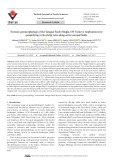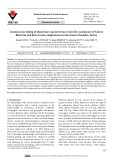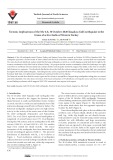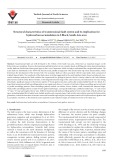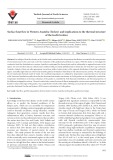
Tectonic implications
-
The Payas region bauxite deposits occur as a sandwiched layer that is a few kilometers long and an average of 10 m thick between the lower and upper Cretaceous carbonates of the Arabian Platform. The bauxites occur as 2 types, comprising blanket and pocket, are chemically and texturally homogeneous, and have a thrust structure with ophiolitic mélange formations. The bauxite varies in color, from reddish-brown to grayish-green to black, and has a massive, patchy, and very rare oolitic-pisolitic texture.
 26p
26p  tanmocphong
tanmocphong
 29-01-2022
29-01-2022
 21
21
 1
1
 Download
Download
-
Herein, a combined analysis of Global Navigation Satellite System-derived strain rate maps, in accordance with recent seismicity, was presented to reveal that the N-S extension is accommodated primarily by strike-slip faulting of the İzmir-Balıkesir Transfer Zone (İBTZ), where a counter clockwise rotation (~25–100°/Myr) along the vertical axis is dominant. The results indicated that strike-slip segments within the İBTZ show variable transport sense and amount of slip along them, and they connect by hard linkage relay ramps with the dip to oblique slip normal faults.
 18p
18p  tanmocphong
tanmocphong
 29-01-2022
29-01-2022
 19
19
 1
1
 Download
Download
-
The southern part of the Western Anatolia Extensional Province is governed by E-W-trending horst-graben systems and NW-SE-oriented active faults. The NW-striking Yatağan Fault is characterised by an almost pure normal sense of motion with a minor dextral strike slip component. Although the settlements within the area have been affected by several earthquake events since ancient times (~2000 BCE), the earthquake potential and history of the Yatağan Fault has remained unknown until a few years ago.
 21p
21p  tanmocphong
tanmocphong
 29-01-2022
29-01-2022
 14
14
 1
1
 Download
Download
-
South Western Anatolia is dominated by E-W and NW-SE trending active faults. The dip-slip Yatağan Fault is one of these active structures that trends in a NW direction for ~30 km. To assess the relative tectonic activity of the Yatağan Fault, two geomorphic segments were defined along the fault: the FS-1 (northern segment) and the FS-2 (southern segment). The vertical slip rate pattern of the fault was analyzed using steepness indexes, chi (χ) plots, and log-log slope area graphs.
 34p
34p  tanmocphong
tanmocphong
 29-01-2022
29-01-2022
 13
13
 2
2
 Download
Download
-
The timing of the deposition of the well-preserved Quaternary marine terraces in the coastal region of northeastern Turkey are crucial in understanding the Quaternary tectonics of the Pontides. The chronology of raised marine terraces between Trabzon and Rize has remained unrevealed because of chronologic limitations. This study aims to establish chronology for the terrace deposits by applying optically stimulated luminescence (OSL) dating methods using single aliquot regenerative dose (SAR) techniques on quartz grains extracted from marine terraces.
 20p
20p  tanmocphong
tanmocphong
 29-01-2022
29-01-2022
 22
22
 1
1
 Download
Download
-
A Mw 6.8 earthquake struck Western Turkey and Eastern Greece that occurred on October 30, 2020 in Kuşadası Gulf. The earthquake epicentre is located north of Samos Island and the focal mechanism solution shows that a normal fault was reactivated. The main shock and aftershock analysis imply that the large earthquake occurred on a north dipping normal fault which might be the western continuation of the Efes Fault in Western Turkey.
 13p
13p  tanmocphong
tanmocphong
 29-01-2022
29-01-2022
 10
10
 1
1
 Download
Download
-
The tectonic evolutionary history between the Xing’an Block (XB) and Songnen Block (SB) in the eastern Central Asia Orogenic Belt (CAOB) has been hotly debated. In this study, we present a series of new data to provide a better constraint on the magmatic process during plate subduction and its implications for the regional tectonic evolution of XB and SB, even the CAOB. The whole-rock geochemistry and zircon U-Pb chronology of syenogranite in the Chaihe area of the Great Xing’an Range have been carried out.
 27p
27p  tanmocphong
tanmocphong
 29-01-2022
29-01-2022
 14
14
 3
3
 Download
Download
-
Transtensional faults are well developed in the S Block of the South Asia area, which have an important impact on the hydrocarbon accumulation. However, the transtensional fault structure is very complex. Based on drilling and seismic data interpretation results, faults are divided into three typical types in the Lower Cretaceous, which can help to understand the complex fault system. The main faults are distributed in the NNW-SSE direction and parallel arrangement with dextral strike-slip shear characteristics, which determines the development of the tectonic belt.
 17p
17p  tanmocphong
tanmocphong
 29-01-2022
29-01-2022
 7
7
 1
1
 Download
Download
-
Knowledge of heat flow density on the Earth’s surface and subsurface temperature distribution is essential for the interpretation of several processes in the crust such as for the evaluation of the geothermal potential of a region. With this study, we investigate the conductive heat flow distribution in western Anatolia to understand the thermal state and its relationship to regional tectonics in the region. The new heat flow data are collected and combined with previously published data to obtain the new heat flow map of western Anatolia.
 17p
17p  tanmocphong
tanmocphong
 29-01-2022
29-01-2022
 10
10
 1
1
 Download
Download
CHỦ ĐỀ BẠN MUỐN TÌM











